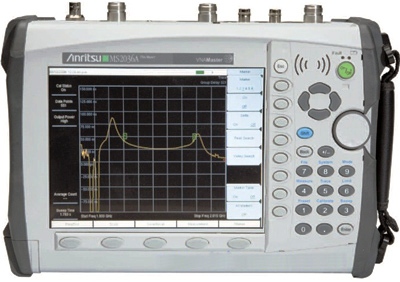A calibration by Custom-Cal is performed by engineers with extensive OEM experience. We have the expertise and the necessary standards to perform the ANRITSU MS2036A Calibration, onsite calibration may be available.
We specialize in quick turnaround times and we can handle expedited deliveries upon request.
Need another Network Analyzer, SNA, VNA?
Shop for Comparable Products on our
used Network Analyzer, SNA, VNA page
or
new Network Analyzer, SNA, VNA page
More
|

|
|
The Anritsu MS2036A VNA Master is a 1-port and 2-port handheld vector network / Spectrum analyzer (VNA), which uses the superior Frequency Domain Reflectometry (FDR) approach instead of the DC pulse technique of older Time Domain Reflectomtry (TDR) approaches. Using FDR, the VNA Master provides convenient 1-port measurements of return loss, VSWR, cable loss, Distance-To-Fault (DTF), and Smith Chart measurements in the field. Connect the VNA Master to a 2-port cable to measure cable loss, phase, and group delay. In other words, the VNA Master offers precise measurement capabilities for cables and antennas by simplifying S11 and S21 measurements in the field.
Vector Network Analyzer Specifications.
Frequency Range: 2 MHz to 6 GHz.
Frequency Accuracy: 25 ppm.
Frequency Resolution: 10 Hz.
Data Points: Low, Medium, High (137/275/551).
1-Port Power High: 0 dBm (typical).
2-Port Power High: 0 dBm (typical).
Corrected Directivity: 42 dB (2 MHz to 6 GHz).
Dynamic Range: 70 dB (2 MHz to 10 MHz), 80 dB (10 MHz to 3 GHz), 70 dB (>3 GHz to 5.5 GHz), 65 dB (>5.5 GHz to 6 GHz).
Return Loss Range: 0 to 60 dB.
Return Loss Resolution: 0.01 dB.
VSWR Range: 1 to 65.
VSWR Resolution: 0.01.
Cable Loss Range: 0 to 30 dB.
Cable Loss Resolution: 0.01 dB.
1-Port/ 2-Port Phase Range: -180° to +180°.
1-Port/ 2-Port Phase Resolution: 0.01°.
Smith Chart Resolution: 0.01.
2-Port Gain Range: -120 to 100 dB.
2-Port Gain Resolution: 0.01 dB.
Maximum Input (Damage Level) into Vector Network Analyzer: Test Port, Type N: +23 dBm, ±50 VDC.
Spectrum Analyzer Specifications.
Frequency Range: 9 kHz to 7.1 GHz.
Maximum Continuous Input: +30 dBm.
Tuning Resolution: 1 Hz.
Frequency Span: 10 Hz to 7.1 GHz plus 0 Hz (zero span).
Sweep Time: Minimum 100 ms, 10 µs in zero span.
Resolution Bandwidth: (-3 dB width) 1 Hz to 3 MHz in 1-3 sequence ±10%; 0-span, 1 Hz to 1 MHz 8 MHz demodulation bandwidth.
Video Bandwidth: (-3 dB width) 1 Hz to 3 MHz in 1-3 sequence.
SSB Phase Noise: -100 dBc/Hz max at 10, 20, and 30 kHz offset from carrier; -102 dBc/Hz max at 100 kHz offset from carrier.
Amplitude Measurement Range: DANL to +30 dBm.
Attenuator Range: 0 to 65 dB.
Attenuator Resolution: 5 dB steps.
Options.
-005 Power Monitor (requires external detector).
-010 Built-in Bias-Tee.
-015 Vector Voltmeter.
-019 High Accuracy Power Meter (requires PSN50 or MA24106A, sold separately).
-025 Interference Analysis, 9 kHz to 7.1 GHz (requires external antenna).
-027 Channel Scanner, 9 kHz to 7.1 GHz (requires external antenna).
-031 GPS Receiver (includes GPS antenna).
|